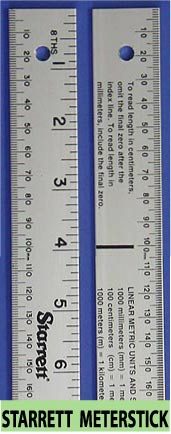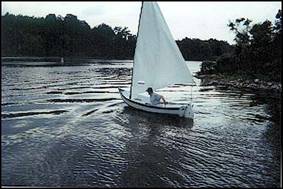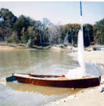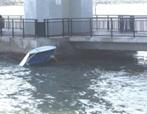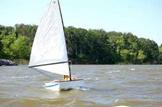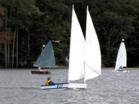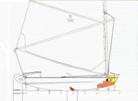| A few months ago, I put up a forum on Yahoo Groups called “Start Sailing @ 60” https://groups.yahoo.com/group/60sailing/ that was essentially meant to encourage senior citizens to become active in home boat building and sailing as a means of staying active and having a hobby that they could enjoy during their retirement years. I also encouraged other builders and designers I knew to join and share their experiences and knowledge with those new to boatbuilding. To date, that approach has only had limited success; so in one of my recent posts, I encouraged other more experienced sailors to recount how they had become addicted to boatbuilding and sailing. I attempted to kick things off by giving an overview of how I personally got involved. (This almost sounds like an AA meeting, doesn’t it?) Here’s my story.
I was first introduced to sailing and boatbuilding about 20 years ago when I was in my early fifties. My son had outgrown soapbox derby cars, but we both had learned some woodworking skills and we were searching around for a new hobby that didn't involve just repairs around the house. A copy of Family Handymancaught my eye at the local supermarket because it was running a series of articles by Harold "Dynamite" Payson on building a small sailboat called the "Cartopper" that had been designed by naval architect Phil Bolger. I bought the magazine, and we were soon involved in building our first small sailboat from the serialized instructions over the next three or four issues.
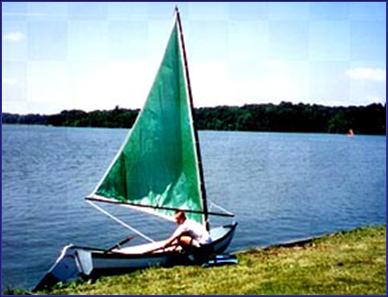
Ryan steadies the"Cartoppe" just prior to ourfirst-ever sailing experience at Eagle Creek Reservior in Indianapolis.
[Does not Enlarge] |
The "Cartopper" was a sweet little 11 1/2' stitch and glue design that could seat two and be rowed or sailed, and we were never prouder than when we applied the final coats of latex paint to her hull. She was to carry a 60 sq. ft. triangular sail that Payson called a "leg o' mutton" which could be purchased, as I learned on the final page of instructions, from Dynamite for about $250.00. However, because that cost was more than I had invested in building the entire boat up to that point, the sail cost seemed to border on exorbitant. I think, too, it was about the time my son turned 16, and the cost of a car and other expenses had pretty much emptied the recreational bank account, so I looked around for other alternatives to get us sailing, eventually settling on a green tarp that sort of matched the green stripe we had painted up under the gunwales. Using some double-faced carpet tape, 1/8" nylon reinforcing line, and some wide vinyl tape that we had used successfully on soapbox derby cars, I taped up a sail, devised some roof racks for our Ford Probe, and headed for Eagle Creek Reservoir on the west side of Indianapolis for a test sail. Our very first attempt to get out on the water ended abruptly when we failed to put the centerboard down as we tried to sail away from the beach where we first put in. Boat, sail, and son were soon entangled in brambles along the shore about 30 feet from where we started. Worse yet, we had a fairly large audience watching and enjoying a good laugh at our expense. Son Ryan was not amused as he picked thorns out of his arms. Fortunately, our tarp sail was not damaged, and we did have oars along. It didn’t take us long to figure out which instruction from the sailing manual we had failed to follow. Ryan rowed us out away from the shore while I put both the centerboard and rudder down, and amazingly, we were soon sailing and challenging the speed of some of the Sunfish that could be rented at the nearby park store. Sailing was a blast, and I, at least, was hooked. Ryan, I think, was not convinced that sailing was more fun than driving, but I like to think that it was this and other sailing experiences with Cartopper that ultimately led him to join the Navy after high school, spend nine years as a Navy nuke, and later enjoy a successful career as a senior reactor operator at a Florida nuclear plant.
Dynamite's book Build the New Instant Boats was probably my first boatbuilding book. Then my wife bought me Sam Rabl's Boatbuilding in Your Own Backyard, and I picked up a used first edition copy of Howard Chapelle's Boatbuilding. Other important books and magazines followed, including Emiliano Marino's The Sailmaker's Apprentice, Reuel Parker's The Sharpie Book, and a number of old magazines from the 1940's called Build 20 Boats. Soon after, I was building a home boatbuilding library, and looking around to see if there were others involved in this fascinating hobby. In the next two or three years, I had learned via an Internet that was still in its infancy about a "Midwest Messabout" hosted in Illinois by a former Boeing aeronautical engineer named Jim Michalak. Jim was engaged in designing a few small prams, canoes, rowboats, and small "sailing sharpies" that could be built from lumberyard materials, and a few of his newer designs had featured tarp sails. By this time I had already built several experimental tarp sails myself and started experimenting with different tapes with the idea of putting together some sail kits from white tarps that I had found a source for on the Internet. I was eager to talk to Jim, so I packed up the Cartopperin the back of my newly acquired Dodge Ram pickup and headed for Rend Lake, Illinois. There I did meet Jim and was thrilled when he asked to take my Cartopperout for a sail. I didn't get to talk much to Jim, who is a little taciturn, but I do remember his opining that tarp sails would never be widely accepted among most boat builders--an opinion that he later changed before he wrote his landmark book Boatbuilding for Beginners (and Beyond). Before I left, I gave him one of my new PolySail Kits to try, hoping he might change his mind. I think I recall that he gave the kit away to a friend, though.
|
Heading out from the ramp at Rend Lake, Illinois, at the Midwest Messabout.
|
Over the next few years, I read a number of books, created a part-time business out of polytarp sail kits, built and restored a number of boats (mostly sharpies and 4' x 8' scows, but including one 16' mahogany runabout and an older racing class sailboat), and met several more people who would encourage the growth of home boatbuilding, including Chuck and Sandra Leinweber who founded Duckworks, and carried my sail kits for a year or two. In fact, their first sail for their Caprice, which has become their flagship for the Texas 200, was built from one of my kits. Since then, that list of acquaintances has grown to include David "Shorty" Routh, the designer of the PDRacer; John Wright, one of the more innovative sailors I know; Mike and Jackie Monies, who together are among the kindest people I have ever met (and perhaps among the best promoters); Michael Storer, the Australian racer, designer, and builder; Andy Linn, the adventurer among us; Carl Kramer, the editor of Wooden Boat magazine, and a host of others who have fueled my addiction for designing, building, and sailing small boats.
|
|
|
Checking the camber of my first white polytarp sail in 1996. |
My 16’ sharpie Foolhardy, shown beachedat the Lake Monroe, Indiana, Messabout, was a very fast boat. |
My 15 ½’ sharpie Essence at our dock on Lake Vista in Fishers, IN |
|
|
|
Dean Herring shows off his newly completed kit PDRacer to an admiring crowd at the Wooden Boat Show in Mystic, CT. |
Ryan’s Z-PDR resting against the pilings of the Hutchison Island Causeway over the Intercoastal Waterway at Jenson Beach, FL |
A mysterious fire consumes both a newly constructed kid’s boat I called Wedgie, and Wild Duck on the way to the 2011 Worlds in Oklahoma. |
|
|
Lame Duck, shown here in good wind at Lake Rend, IL, was my first PDRacer. |
Wild Duck was a biplane rigged PDRacer and the only boat I brought with me to Florida when I moved in 2009. |
|
|
Boatless at the end of 2011, I decided to try one more PDRacer. This is the sketch for Wild Duck’s replacement Dangerous Duck. |
Dangerous Duck begins to take shape in between sails. |
I guess that this history is clearly recorded on my website at https://polysail.com The books that have influenced me are pretty clearly visible on the library page, and many of the boats I have built, and events I have enjoyed, are included on the links pages at https://www.polysail.com/links.htm and in articles such as the one on The Evolution of the ZPD-R https://www.polysail.com/zduck.htm The "Old Boats" pages are among the favorites with people if the hit recorders can be relied upon. These counters are now inching up towards a million hits, so there must be many more aspiring builders out there who are looking for their own “perfect designs” to build. I hope that some of my efforts can make a small contribution toward helping other wannabe sailors in reaching their dreams.
One thing I know about the people I've enjoyed meeting through this addiction to boats is that they are all about sharing. What's your story? |

